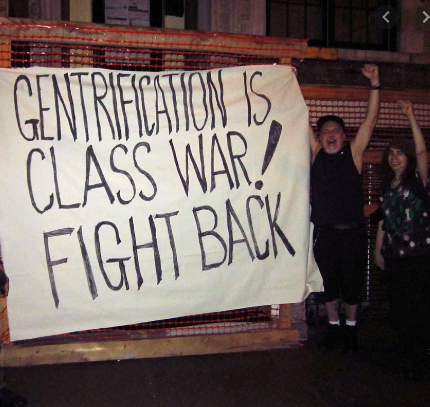Against Gentrification

The Article below was published in Vol. 135, Issue 6 of the Lake Forest College Stentor on March 6, 2020.
By Josh Hager ’22
Staff Writer
Gentrification is a threat to culture and community in the American city, and most importantly, the working-class populations of cities. What is gentrification? Anyone living in a major American city knows plenty about the effects of gentrification, but may not know the term itself. Rising rents, increased policing and surveillance of working people and the homeless, surging homelessness due to evictions and displacement, and the image of hipster cafes with $15 avocado toast in a hip neighborhood of San Francisco are all a result of the harmful practice.
I contend that gentrification is class warfare. Gentrification is the violent process of exploiting and removing working-class tenants and increasing policing of working-class communities and replacing them with middle- to upper-class families. The reality goes beyond hipsters walking around neighborhoods; it extends to evictions, private security and police entering working-class neighborhoods to protect new developments, and working-class people being forced to move because they can’t pay their bills. Gentrification is the naked power of the capitalist class crushing the livelihoods of the working masses.
Urban decay and the legacy of deindustrialization and disinvestment in major American cities allows for gentrification to arise. Neighborhoods that house primarily working-class communities whose jobs may have been shipped overseas, have been neglected by city services, and often have higher amounts of crime are fertile for gentrification. Communities existing in a state of deprivation and decay are also the result of class warfare, and capitalists seeking more wealth see these neighborhoods as opportunities to make more money with real estate development. Developers then act to profit from the communities, landlords demolish old apartments, stop facility maintenance, or raise rents for existing tenants to push them out. Landlords are not beyond using dirty and immoral tactics. According to Serve the People LA, a self-described “community mass-line political organization,” Charles Quarles, an infamous landlord in South Central Los Angeles, demanded a rent increase between $800 and $1,000 from his tenants before 2019’s holiday season. On the northwest side of Chicago, in the gentrified Logan Square neighborhood, some new luxury developments are charging over $1,975 for a studio apartment, and $3,475 for a two-bedroom apartment.
Beyond its immediate effects on the working class, gentrification also has long-term effects on the very soul of American cities. For example, the proposed Lincoln Yards development in Chicago has nothing to do with Chicago culture, instead, it’s as if the suburbs are to be airlifted into the middle of former steel mills. Developments like Lincoln Yards are uninspired, soulless monuments to their own foul nature. They promote a city where the primary task of living is blind consumption. Another example, San Francisco, California, comes to mind. Once a city of the bohème, of working-class communities, a cultural epicenter, an immigrant hub, the metropolis is losing its unique character to a sanitized techie culture that cares more for its investment returns and inventing the next useless gadget rather than community, culture, and those who once lived there. Murals that were painted by the community for the community are torn down and replaced with blandness or are “artwashed” with new ones trying to claim the art and spaces for the gentry.
One counterpoint to anti-gentrification organizing is that the original community will benefit from improved infrastructure and the potential of lower crime rates. But who really benefits from this? Certainly not communities that are being literally evicted from their homes, becoming homeless from displacement, or arrested by a Los Angeles, San Francisco, New York City, or Chicago police officer who sweeps into the neighborhood to protect private property.
To combat and resist gentrification, it is up to the masses, guided by militant organizations who will, with the masses as fully willing fighters, destroy it, and ultimately link it to a broader fight against capitalism. This does not include simply voting for reforms by politicians who do not have the class interest to defend the militant working class, including supposedly leftist politicians, but a revolutionary organization of the masses by the masses. For example, Defend Boyle Heights, a revolutionary anti-gentrification organization based in the Boyle Heights neighborhood of Los Angeles, who, with the masses of Boyle Heights and guided by revolutionary theory, has successfully rallied many working-class people to resist the destruction of their community. Art galleries, often opened by gentrifiers as the first wave of gentrification, have been kicked out five times from Boyle Heights. The organization recognizes that Los Angeles’ politicians, fully in cahoots with developers, won’t solve their problems, so they turn to the masses themselves. The same should be done in Chicago!
